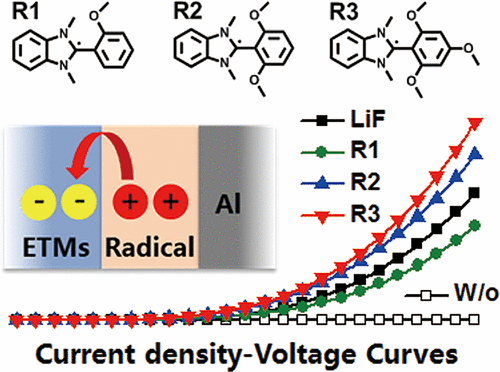当前位置:
X-MOL 学术
›
J. Phys. Chem. Lett.
›
论文详情
Our official English website, www.x-mol.net, welcomes your
feedback! (Note: you will need to create a separate account there.)
Organic Radicals Outperform LiF as Efficient Electron-Injection Materials for Organic Light-Emitting Diodes
The Journal of Physical Chemistry Letters ( IF 4.8 ) Pub Date : 2017-09-19 00:00:00 , DOI: 10.1021/acs.jpclett.7b02125 Zhengyang Bin 1 , Ziyang Liu 1 , Lian Duan 1
The Journal of Physical Chemistry Letters ( IF 4.8 ) Pub Date : 2017-09-19 00:00:00 , DOI: 10.1021/acs.jpclett.7b02125 Zhengyang Bin 1 , Ziyang Liu 1 , Lian Duan 1
Affiliation

|
One of the key issues for organic light-emitting diodes (OLEDs) is to achieve high electroluminescence efficiency and high power efficiency, which requires extremely efficient electron injection and thus low driving voltage. Here, we design a series of precursors for reactive organic radicals according to theoretical calculations and achieve efficient electron injection by using a highly reducing radical on the surface of the electron injection layer to reduce the electron injection barrier through an interface charge-transfer process. In contrast to bulk charge transfer in electron-transporting material, interface charge transfer allows us to make efficient electron injection at contact without introducing any structural and electronic disorder to electron-transporting material. 2-(2,4,6-Trimethoxyphenyl)-1,3-dimethyl-1H-benzoimidazol-3-ium (R3), with the strongest electron-donating ability, could largely reduce the electron injection barrier and outperform the previously reported organic radical (2-(2-methoxyphenyl)-1,3-dimethyl-1H-benzoimidazol-3-ium, o-MeO–DMBI or R1) and the widely used electron injection material (LiF) to boost device performance.
中文翻译:

作为有机发光二极管的高效电子注入材料,有机自由基的性能优于LiF
有机发光二极管(OLED)的关键问题之一是实现高电致发光效率和高功率效率,这需要极高效的电子注入,因此驱动电压也很低。在这里,我们根据理论计算设计了一系列用于反应性有机自由基的前体,并通过在电子注入层表面使用高度还原的自由基来减少电子注入势垒,从而通过界面电荷转移过程实现了有效的电子注入。与电子传输材料中的大量电荷传输相反,界面电荷传输使我们能够在接触时进行有效的电子注入,而不会给电子传输材料引入任何结构和电子紊乱。2-(2,4,6-三甲氧基苯基)-1,3-二甲基-1H-苯并咪唑-3-鎓(R3),o -MeO–DMBI或R1)和广泛使用的电子注入材料(LiF)来提高器件性能。
更新日期:2017-09-19
中文翻译:

作为有机发光二极管的高效电子注入材料,有机自由基的性能优于LiF
有机发光二极管(OLED)的关键问题之一是实现高电致发光效率和高功率效率,这需要极高效的电子注入,因此驱动电压也很低。在这里,我们根据理论计算设计了一系列用于反应性有机自由基的前体,并通过在电子注入层表面使用高度还原的自由基来减少电子注入势垒,从而通过界面电荷转移过程实现了有效的电子注入。与电子传输材料中的大量电荷传输相反,界面电荷传输使我们能够在接触时进行有效的电子注入,而不会给电子传输材料引入任何结构和电子紊乱。2-(2,4,6-三甲氧基苯基)-1,3-二甲基-1H-苯并咪唑-3-鎓(R3),o -MeO–DMBI或R1)和广泛使用的电子注入材料(LiF)来提高器件性能。











































 京公网安备 11010802027423号
京公网安备 11010802027423号